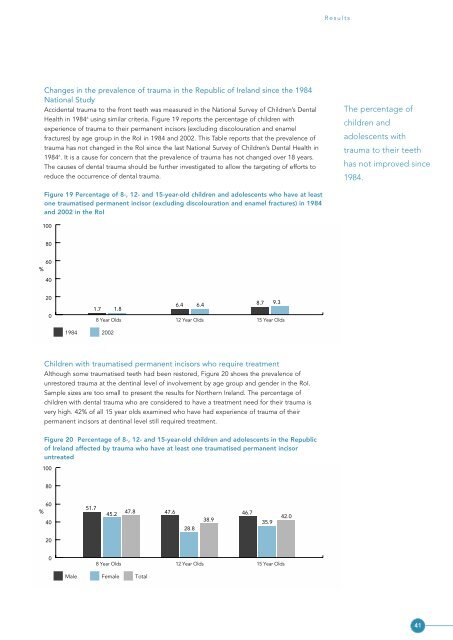Oral Health inside - Communities and Local Government
Oral Health inside - Communities and Local Government
Oral Health inside - Communities and Local Government
Create successful ePaper yourself
Turn your PDF publications into a flip-book with our unique Google optimized e-Paper software.
ResultsChanges in the prevalence of trauma in the Republic of Irel<strong>and</strong> since the 1984National StudyAccidental trauma to the front teeth was measured in the National Survey of Children’s Dental<strong>Health</strong> in 1984 6 using similar criteria. Figure 19 reports the percentage of children withexperience of trauma to their permanent incisors (excluding discolouration <strong>and</strong> enamelfractures) by age group in the RoI in 1984 <strong>and</strong> 2002. This Table reports that the prevalence oftrauma has not changed in the RoI since the last National Survey of Children’s Dental <strong>Health</strong> in1984 6 . It is a cause for concern that the prevalence of trauma has not changed over 18 years.The causes of dental trauma should be further investigated to allow the targeting of efforts toreduce the occurrence of dental trauma.The percentage ofchildren <strong>and</strong>adolescents withtrauma to their teethhas not improved since1984.Figure 19 Percentage of 8-, 12- <strong>and</strong> 15-year-old children <strong>and</strong> adolescents who have at leastone traumatised permanent incisor (excluding discolouration <strong>and</strong> enamel fractures) in 1984<strong>and</strong> 2002 in the RoI1008060%402001.7 1.86.4 6.4 8.7 9.38 Year Olds 12 Year Olds 15 Year Olds1984 2002Children with traumatised permanent incisors who require treatmentAlthough some traumatised teeth had been restored, Figure 20 shows the prevalence ofunrestored trauma at the dentinal level of involvement by age group <strong>and</strong> gender in the RoI.Sample sizes are too small to present the results for Northern Irel<strong>and</strong>. The percentage ofchildren with dental trauma who are considered to have a treatment need for their trauma isvery high. 42% of all 15 year olds examined who have had experience of trauma of theirpermanent incisors at dentinal level still required treatment.Figure 20 Percentage of 8-, 12- <strong>and</strong> 15-year-old children <strong>and</strong> adolescents in the Republicof Irel<strong>and</strong> affected by trauma who have at least one traumatised permanent incisoruntreated1008060%4051.745.247.8 47.628.838.946.735.942.02008 Year Olds 12 Year Olds 15 Year OldsMale Female Total41
















